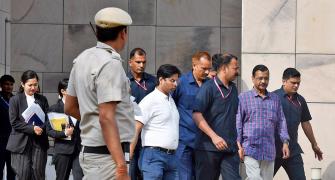On a weekday, the DLF Mega Mall -- located in the IT and ITES hub of Gurgaon on the outskirts of Delhi -- bears a deserted look. Of the few operating shops in this large mall, most have nary a customer. The same goes for several other retail outlets and many of the other malls in the vicinity.
True, a retail chain like Future Group's Big Bazaar may be clocking heady sales (growing at 100% year-on-year), but the dozen-odd shops operating in its proximity wear a deserted look, giving a somewhat hollow ring to the much-talked-about retail boom in the country.
In what seems like a quirk of circumstance, malls have sprung up all over urban India in anticipation of a consumption boom that may itself prove to be eventually truant.
Move to Mulund (West), a suburban locality of India's financial nerve, Mumbai. Rajesh Parashar, a resident of the area has the option of shopping at Big Bazaar, Apna Bazaar, Subhiksha, Spinach, Shoprite, Foodland or at the local Sai Supermarket, all of which are within a two-kilometre radius of his residence
This is paralleled by the developments happening in the Delhi suburb of Ghaziabad, where the upcoming Shipra Mall at Indirapuram already has Big Bazaar operating out of its lower-ground floor, while Reliance is slated to open shop on the third floor. Customer footfalls, however, are more in the projections of the occupiers of the mall than real.
All this retail activity, and more, and the sheer gargantuan size of the investments planned, beg the question -- does the consumer's wallet have enough money in it for everyone?
"Only time will tell," is KPMG's executive director, Deepankar Sanwalka's laconic answer. To a great extent the success or the failure of malls will hinge on the consumer population of the area. "If the spending power of consumers is high in a locality, it could sustain two-to-three large players." Not so, elsewhere, he adds poignantly.
The significance of these remarks sinks in gradually. With planned investments of $22 billion over the next five years -- excluding what might be brought in by new global and large local players henceforth -- the retail sector is expected to grow 40% to $427 billion by 2011.
Organised retail, which is 3% of the whole currently, is in turn pegged to grow to $64 billion by 2015. And one consequence of all those investments will be the fact that India's present two square-feet per capita retailing space will rise 15-20% by 2010.
To be viable, the huge investments made in the sector by India Inc would have to be responded to by a corresponding massive surge in footfalls. And for that to happen, a lot of links would have to fall in place.
Between the drawing board and the emerging market realities, the realisation dawns that a lot of things can go wrong with India's much-heralded retail revolution. The more visible among these loose ends: vexingly high real estate prices, the loosely-knit distribution networks in India's hinterland, the near-absence of any modern supply chain logistics, shortage of skilled personnel, and a regulatory system that resembles a patchy quilt more than anything else.
Then there is the nature of the business itself. Retailing is a low-margin, high-volume, commodity business where profitability gets strained as competition intensifies. And if wrong choices are made regarding the location or the formatting of the store, woe betide the retailer. The catches are many and to make it big, a retailer would have to negotiate all the tricky turns most of the time.
The big players are sanguine, however. "There is enough room for six-to-eight players," says Reliance group chairman Mukesh Ambani, who recently kicked off the first Reliance Fresh outlet in Hyderabad. There are reasons for his optimism: the country's preponderantly young working population, disposable incomes that are expected to increase at an average 8.5% per annum till 2015, and a steadily climbing per capita income (from $460 in 2002, it rose to $620 in 2005).
In fact, it is the expectation of a large working and earning population that has attracted most global retailers to the country. But most analysts are agreed that the Indian retail market could at best support 10 large players with revenues in excess of $2 billion each by 2015.
Given the number of players getting into the fray today, this clearly means a winnowing out of the weaker retail players. What's more, that time could be sooner rather than later, maybe just three or four years down the line.
That's not so surprising, industry insiders even say, pointing out that a large number of the new entrants may not be committed to retailing in the long term. While some almost certainly are looking to act as silent partners for foreign players, others may be more willing to look at an exit option a few years down the line.
Says Hemant Kalbag, principal, AT Kearney: "I see consolidation happening in the next five years. That's when the shakeout will happen and the successful retailers will look acquiring less profitable ones."
But that's still in the future. As of now, the retail turf is set for some frenetic activity. Reliance has drawn up a
Rs 25,000-crore (Rs 250 billion) retail plan that would see its outlets dotting 784 cities and small towns by 2010.
Already it has 17 stores in Hyderabad alone (the number will go up to 40 by end of the above period). More recently, Sunil Bharti Mittal made news when he announced an alliance with the world's biggest retail chain Wal-Mart, for a supply chain and cash-and-carry venture, besides a franchise agreement for retail.
Seen as a coup of sorts, this could exert pressure on other retailers in the country to explore similar collaborative opportunities.
Laying The Pipeline
Between them the likes of Reliance, the AV Birla Group, the Tatas, the Godrejs, the Bhartis, the Mahindras, the ITC Group and the Wadias -- and a horde of others -- will be sinking in close to Rs 1 lakh crore (Rs 1 trillion) in the business of retail over the next five years.
In their crosshairs, are a host of retail-related activities such as cold chains, retail supply logistics, warehousing, sourcing and merchandising management. All of which are seen as absolutely essential if the front-end retail business is to take off on a meaningful scale across the country.
The players have hit the ground running. Reliance is hiring overseas talent to beef up its management capabilities -- it has roped in Peter Bracher from Asda Wal-Mart as special adviser for Reliance Fresh stores and Kevin Pleass from Tesco, UK, to help with store design and construction -- even as the AV Birla group is on a talent hunt ahead of its Rs 15,000-crore (Rs q50 billion) retail rollouts.
Retail icon Kishore Biyani is also stepping on the gas -- he has announced plans to roll out 225 Big Bazaar stores and hundreds of other outlets in other formats in the next four years.
The Tata group too earlier this year expanded its footprint (beyond the formats rolled out by group company Trent of Westside fame) by entering the durables segment, in a tie-up with Australian retailer Woolworths, with the launch of its Croma store.
"We plan to have a national presence with 30 stores by March 2008 and double it to 60 by March 2009, with a capital of Rs 400 crore (Rs 4 billion)," says RK Krishna Kumar, Director, Tata Sons, who is spearheading Tata's retail venture.
He adds that the company zeroed in on the segment given the findings of an internal study, which revealed that only 0.5% of Indians own air conditioners, just 1% own computers, 3.5% washing machines and 11.7% telephones. Other players like the Dubai-based Landmark group, with its Lifestyle and Max branded outlets, are also keen to expand into the grocery segment.
Reports indicate the company is in talks for a tie-up with Carrefour. Then there are players like the K Raheja group's Shopper's Stop and the Rajan Raheja-controlled Globus that are expanding their reach in the apparel and accessories segments. Others like ITC (a big player in its own right), the Godrej group, Century Textiles and Raymond as well as mid-size players like Vishal Megamart, Subhiksha and Sabka Bazaar are busy increasing their footprint.
Taking a cue from the global leaders (whose eyes are also on India), India Inc's retailers are thinking big. Reliance Retail, for instance, has chalked out a plan to roll out about 5,500 stores of all kinds in 800 cities, 85 logistics centres and 1,600 farm supply hubs. AV Birla Group is looking at pumping in Rs 15,000-20,000 crore (Rs 150-200 billion) -- with an initial investment of Rs 5,000 crore (Rs 50 billion) in the next few years.
Similarly, Bharti is expected to invest Rs 6,000 crore (Rs 60 billion) in the initial phase. Biyani's Pantaloon is not far behind. The group plans to increase its total retail space to 30 million sq ft from the current 3.2 million sq ft; and take its turnover to Rs 2,500 crore (Rs 25 billion) by June 2010.
By global scales, the numbers are not out of the ordinary. The Bentonville, Arkansas, based Wal-Mart -- the big brother of retailers -- operates 6,640 stores and wholesale clubs in 14 countries, while its counterpart in Europe (it is based out of UK) Tesco runs 2,600 across 13 countries.
The others have chains of comparable sizes and reach. To keep their stores stocked with their myriad products, the global retailers have sophisticated procurement strategies in place that hinge on sourcing products globally based on prices, quality and timely delivery.
Not to mention deployment of cutting-edge technologies that enable real-time inventory tracking and ordering mechanisms. "Tesco, for instance, can sell jeans for £2 as bulk buying can help it source the same from its global suppliers at far less than this," says KPMG's Sanwalka. Thus, globally, retail is a business involving massive scales and deep pockets.
Climbing The Greased Pole
Moving up the evolutionary ladder won't be easy for India's retailers. Especially given the large number of potential spoilers. Availability of quality retail space will be a key determinant for the growth of the sector. With most Indian cities undergoing rapid urbanisation, spiralling rental costs has most retailers worried already.
Hitherto, most retailers have preferred to go in for long-term leases. But with real estate prices in most top tier cities hitting the roof in the past two years, lease rental increases are making business unviable for organised retail.
According to PricewaterhouseCoopers (PwC), the current average lease rentals across some of the top cities range from Rs 88 per sq feet per month to as high as Rs 120 per sq ft per month. On an average, lease rentals account for 7-8% of the revenue and 40-45% of the non-material cost for retailers. Unless these prices stabilise, most retail businesses could end up taking much longer than originally planned to break even.
Not surprisingly then, within hours of making his deal with Wal-Mart public, Sunil Mittal, the chairman of Bharti Group, said his top priority would be real estate acquisition, whether through leasing or buying.
To that end, the newly-formed combine is roping in DLF, Emaar, MGF and Ansals to act as partners and developers. Such an arrangement could prove to be a win-win solution: while it will ensure quick roll-outs and lower capex, it could also improve asset utilisation of the developments. At the other end, players like Reliance could set up hypermarkets in their own SEZs to meet the needs of local residents.
Another way out of this problem, as some astute retailers have found out, is to become an anchor tenant. According to PwC estimates, an anchor tenant typically commands a discount of 30-45% on lease rentals and is responsible for attracting footfalls into a mall.
Retail biggies like Pantaloon Retail, Shopper's Stop and McDonald's have been quick to endorse this strategy. For instance, Pantaloon has signed up with 100 of the 300-odd malls that will be developed over the next three years. This, points out PwC, will enable the retailer to leverage its first-mover advantage on a pan-India basis.
Pantaloon Retail currently has 3.2 million sq ft spread across several formats and is expected to have 10 million sq ft of space in the country by 2010. Again, in Tier-II cities, where lease rentals are 40-50% lower than those in top tier cities, Pantaloon has been quick to establish its presence.
The retailer's real estate fund, Kshitij 1, which has a corpus of $80 million at its disposal, is understood to have invested in projects in cities like Ahmedabad, Baroda and Surat. Pantaloon expects to have nearly 400,000 sq ft of retail space in these destinations by 2008.
The other determinant of success here is the location -- if the outlet is not easily accessible by a large section of consumers due to distance or other issues, viability could come in question.
Here the neighbourhood format has an edge. Sanwalka of KPMG is of the view that smaller stores of 1,500-2,500 square feet (as against 150,000 square feet hypermarkets) in neighbourhoods might do better in India. The verdict is still out on that one, and we won't know till one fails.
Adds KPMG's associate director Kaushika Madhavan, "All new entrants are planning rapid expansion and such a scale of ramp-up requires scalable processes and systems, which retailers are yet to develop. So we would witness mistakes being made as Indian retail evolves. Ability to learn from mistakes will be a critical success factor." And here deep pockets will help.
While Biyani already has a successful retail model in place and Bharti will look to cut corners with some help from Wal-Mart, players like Reliance and the AV Birla group would have to go through a longer learning curve.
Grapevine has it that soon after the Bharti-Wal-Mart MoU, Reliance Retail's A-team went into a huddle to discuss its response. The fact that the world's biggest retailer will be pitted against them has not been lost on them: now, Reliance has to worry about Wal-Mart's strength in the make-or-break area of supply-chain management.
This will no doubt be factored into the retailer's own mammoth Rs 6,000-crore drive to set up its own logistics, complete with its own airstrips and a fleet of transport aircraft dedicated to airlifting supplies to key markets.
Indeed, the key imperative facing retailers in India is that of creating robust, scalable supply chains that would facilitate their rapid spread across the country. "India is a fragmented country and an absence of a strong infrastructure and logistics system makes it all the more challenging to reach consumers," says NV Sivakumar of PwC.
A vital logistical link in most retailers' plans happens to be the cold chain. And many of them like Reliance Retail and Future Group are reported to be investing Rs 6,000 crore and Rs 400-500 crore (Rs 4-5 billion), respectively, on setting up logistics.
Another big player in the segment will be the Bharti Group. Overhauling this part of the supply chain will be key to the success of any retail venture in food and groceries segment. Currently in India, the wastage levels for perishables are as high as 40% because of a large number of intermediaries as well as loss during transportation as well as through lack of storage.
Says KPMG's Madhavan: "The fact is that most retailers in India still don't have a stronghold on operations -- be it merchandising, supply chain management or procurement."
Clearly, while the players can build on the experiences of industry leaders in other markets while developing their supply chain, the Indian market may require them to improvise frequently.
Foreign retailers have shown that managing operations innovatively can provide a significant competitive advantage to retailers. Wal-Mart, for instance, leverages IT to track supply chain processes like cross-docking very effectively. Similarly, Tesco requires lean production techniques of its suppliers and has high-reliability delivery systems in place such as 'milk-runs'.
Most analysts agree that retailers would have put in place global operational metrics.
One way to measure efficient operations is the inventory turns ratio. A comparison of the US and India is revealing. Where, in the US, the retail sector has an average inventory turns ratio of about 18 (some retailers like 7-Eleven score over 50), most Indian retailers range between four and 10, says KPMG.
The other key metric -- stock availability -- is telling too: Where global retailers achieve more than 95% availability of all stock-keeping units on the retail shelves, their Indian counterparts cut a rather poor figure at 5-15%.
There are other areas that retailers would have to master -- such as reaping economies in procurement and transportation, bulk storage, trend forecasting to minimise inventory levels -- before they can truly claim to have arrived.
Early entrants such as Shopper's Stop and RPG Group are acutely aware of this truth: both took years to bring their supply-chain models to the present efficiency levels. Even a player like the Dubai-based Landmark Group -- which has been operating in India for eight years now -- insists it still needs to bring their ERP solution system up to speed.
Others may face new, unexpected problems. Scalability is what the likes of Kabir Lumba, Executive Director, Lifestyle International, is banking on for growth. The group, which currently runs 12 stores, plans to open 45 more stores at a cost of Rs 450 crore (Rs 4.50 billion) over three years. Lifestyle's stores attract 40,000 customers every day, and are projected to close fiscal 2006-07 with a sales turnover of Rs 500 crore.
Again, when it comes to technology adoption and usage, there's a yawning gap between the Indian retailers and those in the West.
According to a recent survey conducted among the country's top retailers by KPMG, while retailers like Wal-Mart and Metro have started using RFID technology (offering high inventory visibility), retailers in India are still to take to bar coding. As systems grow in size and complexity, retailers would have set aside increasing amounts as IT spend.
The challenge posed by the global retailers is clearly formidable. But local retailers' more intimate understanding of their customer base will help them survive.
Besides, even the world's largest retailers have slipped when it comes to the emerging markets -- Wal-Mart was forced to rework its model in Mexico and a similar thing happened to Carrefour in China, where it had to revise its strategy. Also, Wal-Mart's track record in markets such as South Korea and Germany has been nothing to write home about.
The other big issue for retailers is people. Analysts agree that the manpower shortage will get acute as retail spreads beyond the metros. Says Sanjiv Goenka, Chairman, RPG Group: "The biggest challenge for us and, for that matter, any retailer will be getting trained personnel."
The Manufacturing Angle
With Wal-Mart's advent in the US, the relationship of manufacturers with consumers was drastically altered in the latter's favour. While the results in the case of India's retailers may not be necessarily as dramatic, some major changes would definitely be in order.
Strategic sourcing tie-ups between retailer and manufacturer will be the main drivers in this respect. A few weeks after Reliance rolled out its retail plan, one of the first things it did was to negotiate with leading FMCG companies, including Dabur India and Nestle India, for a direct retail account for the products they sold at its outlets. Earlier this year, Pantaloon did a similar exercise and sought 5% higher margins for products sold at its Big Bazaar and Food Bazaar outlets.
Says Atul Joshi, head of the no-frills chain Subhiksha's northern operations: "For an FMCG manufacturer, the cost of dealing with us (modern retail) is negligible. We were the first direct retail account with HLL about seven years ago." The no-frills chain assures 8-10% discount to consumers on all products it stocks.
While retailers like Reliance, Pantaloon or Subhiksha may be bringing a change, the fact is that ordering or sourcing by retailers is still tactical than strategic, points out a KPMG study. Not many retailers have long-term agreements with suppliers.
Also, traditionally retailers have played a passive role in this relationship. In contrast, Wal-Mart actively partners with manufacturers who supply it products to ensure that consumers are offered prices at the lowest prices possible. In fact, it was precisely the retailer's legendary aggression in bargaining that partly drove the massive wave of restructuring of the US industry.
Indian retailers have their work cut out in this regard, but it is far from clear whether they would be able to emulate this dimension of Wal-Mart's success story.
More likely, the retail chains coming up will be less combative in their approach towards manufacturers. "We will have to have a collaborative approach. But the threat from retail to packaged goods industry will prompt companies to invest a lot in R&D," says Adi Godrej, chairman, Godrej Industries.
The statement's import is not lost -- private labels have a big potential as promotional costs are low for retailers and the margins fat (as much as 60% against 35% for others). Also, these non-branded products can be offered at far lower price points, generating volume sales.
Getting It Right
Organised retailers in India are trying out a variety of formats, ranging from discount stores to supermarket to hypermarkets to specialty chains. However, of late, most players appear to be gravitating towards the hypermarket format.
Retailers ranging from Pantaloon to RPG to Piramals or the Tatas are working towards exploiting this model, perceived by consumers as more value-enhancing. But in the long run, what is most likely to succeed is a more balanced multi-format strategy.
This helps retailers adapt to the very different shopping patterns that can exist within the country and even within regions. Here again, merely copying global trends will not help. In a research conducted by KPMG International in developed markets, it was found that single-format players generated higher shareholder value than multi-format ones.
Some feel a combination of cash-and-carry and neighbourhood stores, as in a hub-and-spokes model can be a good bet. Says one retail analyst, nascent markets like India need a lot of room for experimentation on part of the retailers. Ergo, there are no cut-and-dried solutions when it comes to fixing on the right retail format.
Finally, while in the first flush of the retail boom, the elimination of traditional intermediaries may bring windfall gains (as well as bring welcome and much-needed relief to the producers), this source will increasingly dry out as competition intensifies and margins come under pressure a few years down the line.
What would set the survivors apart from those who are forced to sell out (or go belly-up) will be differentiators like location, value-added services (convenience), private labels and customer loyalty programmes, other than price. The last, a result of retailer-manufacturer tie-ups, state-of-the-art supply chain infrastructure, global sourcing and scale will be a key factor. And, if experience in other markets is anything to go by, an uncanny ability to read shifting trends.







